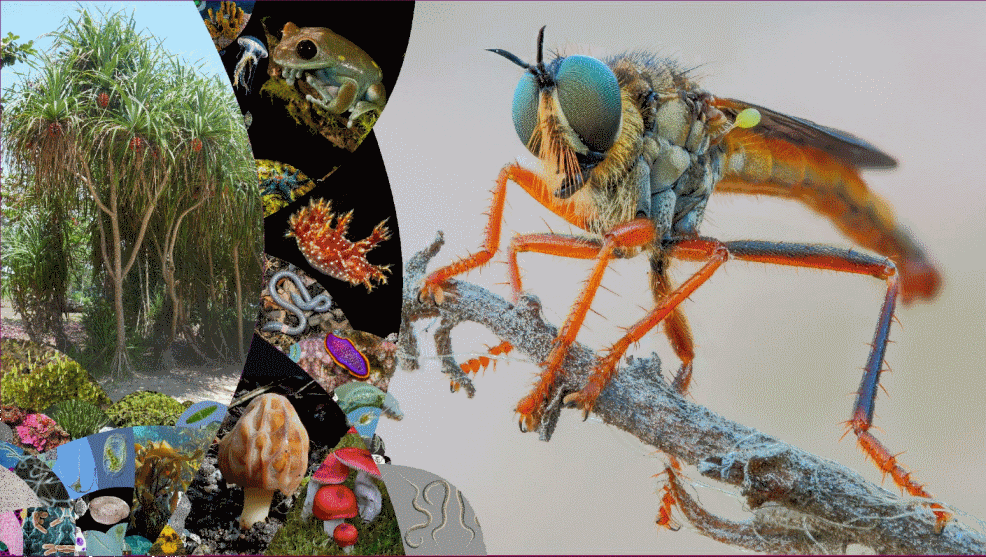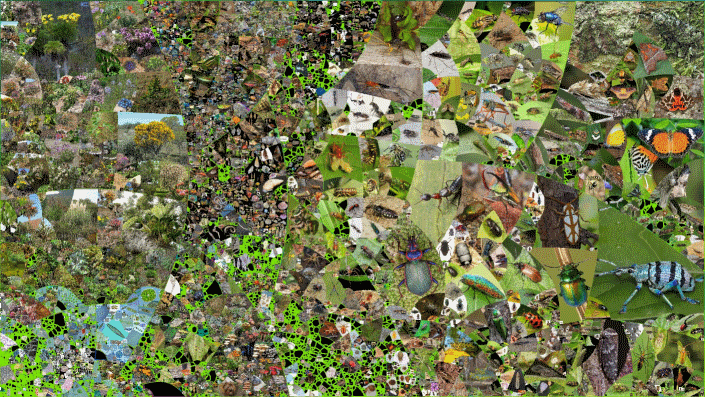LifeGate 2021 is an interactive two-dimensional phylogenetic map. It is an attempt to arrange all known species (2.6 million) phylogenetically in an interactive zoomable user interface.
The map view provides different levels of taxonomic detail and can be navigated by zooming between the following colour-coded taxonomic levels:
- Domain,
- phylum (the starting point of the map),
- class,
- order,
- family,
- genus,
- species.
The surface area of a taxonomic group is relative to the number of its species—more species rich clades are represented with a larger area. For instance, there are more than twice as many ant species in the family Formicidae than in the whole class of mammals (Mammalia). For the arrangement of the taxa a self-similar numeric Voronoi approach has been used. Within a group, taxa are arranged so as to reflect their phylogenetic relationships. Taxa with fewer species (often constituting relict taxa of phylogenetically older branches) have been placed to the lower left corner of their respective edge. Only extant (contemporary) taxa are shown.
For the individual taxon, additional information can be retrieved, including phylogenetic trees. Many of the cells have already been filled with photographs showing a representative of the respective taxon. Thereby, the map presented here aims to combine up-to-date phylogenetic knowledge with a graphical display of the richness and aesthetics of life on Earth.
- Phylogenetic arrangement of more than 2.8 million distinct taxa (of which 2.6 million species)
- Zoom between taxonomic levels from domain to species; global and close-up views for the different taxonomic levels
- Search for taxon names, scientific synonyms at the species level, and English and German common names
- More than 150,000 photographs (used with kind permission of the original authors)
- More than 12,000 distinct phylogenetic trees available at the different taxonomic levels
The interactive phylogenetic map works just like other online map services: You can zoom in and out, pan the map view, search, and retrieve additional information at a specific location on the map.
Zoom: Use the mouse wheel (on a PC mouse), the scroll gesture (on a mouse pad), or use the pinch gesture (on touch devices) to zoom through the different taxonomic levels in automatic zoom mode.
Start view (phylum)
Zoomed in (genus)
Zoomed out (family in fixed zoom mode)
When switching to fixed zoom mode, the current taxonomic level will be kept on zoom. This allows for global overviews or close-up views at the selected taxonomic level.
Context menu: To get additional information about a taxon, navigate to its position in the map. Then, open the context menu with a right click (on a PC mouse), with a prolonged tap (on touch devices), or use CTRL+click (on Macs).
By selecting a tab in the context menu you can view the internal phylogeny (sub-taxa of the selected group), external phylogeny (parent taxon and sibling taxa) or the taxonomic classification. On the species level, a list of scientific synonyms is provided.
For taxa that are represented by a photograph the context menu also provides information about the original authors and, if available, a link to the image source.

Phylogenies, taxonomy
& image source
Search: To search for taxa, start typing into the search bar. You can search scientific and common names and on all supported taxonomic levels, e. g. Insecta, Mammals, Bacillus, Common Snowdrop, or Boletus edulis.
You can share links to taxa of the interactive LifeGate map. The link address can be retrieved and copied by clicking in the lower right hand corner of the context menu for the taxon you wish to link to.
Links are given in a certain format:
https://lifegate.idiv.de#@ [phylum (if existing)] - [taxon]
e. g. for the wild pansy: It is recommended to always specify the phylum when linking to taxa of lower taxonomic ranks. This is due to potentially ambiguous taxon names below the phylum level. For instance, the genus
Iris denotes both a taxon of vascular plants (
Tracheophyta-Iris) and an arthropod (
Arthropoda-Iris).
Part of the phylogenetic backbone of the project has already been published for vascular plants in the
Leipzig Catalogue of Vascular Plants (LCVP). LifeGate is one of the largest projects of its kind and the very first attempt of a comprehensive two-dimensional phylogeny on the species level using the Voronoi approach.
Interesting projects of other authors can be found here:





